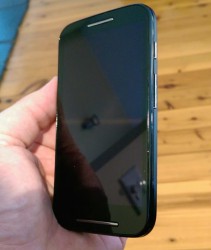
When I attended the Motorola breakfast announcing the Moto E and Moto G 4G back in May this year, I had to say that at least in relation to the E, I didn’t have high hopes. By that stage, I’d already reviewed the Moto G, and while it (then) lacked a 4G option, it seemed to me to be the quintessential ‘budget’ phone; a price-tag under $300, and features that knocked many phones out of the park even up to the $500 mark. It was the right size, the right feature set, and the right power for the market.
The Moto E slots in below the Moto G, but that doesn’t mean that it’s instantly written off. You see, the Moto G set a pretty high benchmark for features vs cost, but I have a sneaky feeling that the Moto E sees that feat, and redoubles it.
The Moto E is cheap. Really cheap. As in, you could buy each of your kids one of these and if they ruin it, shout at them a little before just buying a new one. That’s not to say the Moto E isn’t durable (because it certainly appears that it is), but it is designed with just this in mind — it’s cheap, affordable, and high quality. While it’s primarily targeted more at emerging markets than the Australian market per se, the Moto E is definitely here, and it’s something that’ll probably be a great first smartphone for the next generation.
- The Moto E runs (basically) stock Android, so it’ll be updated pretty quickly.
- Battery life that lasts all day, and then some more.
- A good size for the average hand.
- There’s no 4G here, but frankly, what did you expect?
- Qualcomm’s Snapdragon 200 is slow compared to what’s in most other phones, and you notice it.
- The camera is pretty poor.
Hardware
You might think that for $179 you don’t get a lot of hardware, and that the Moto E will soon be gracing the discount shelves at Coles. You’d probably be wrong on that.
Inside is a Qualcomm Snapdragon 200 Dual-core 1.2 GHz Cortex-A7, which can boost up to 1.4 GHz as needed. While the Snapdragon 200 is far from the newest kid on the block, it’s still a powerful little unit. The balancing act is that it combines reasonable power with super efficiency, which does wonders for battery life.
This is the same CPU that resides in other mid-range handsets, including Sony’s Xperia E1 and E1 Dual and LG’s mid-range handsets. Even some other known cheaper brands, like Huawei, ZTE and even Nokia have used it.
Moving on from the CPU, the Moto E features modest storage options as well — 4GB of internal storage, and just 1GB of RAM (this, in an era where twice is the standard, and some phones are offering up to 3GB now).
The upside is that the storage is expandable, with a MicroSD slot adding up to a further 32GB of storage for you to use. While Android has somewhat changed the way that MicroSD cards are able to be used, they still present a viable option for ‘bulk’ storage, for music, videos and photos. The downside? With 4GB of space, only about half of that is actually available to use. There’s not a huge amount of space to install apps and games (unless they make use of the SD storage, which many don’t).
Keeping all this running is a 1980 mAh battery. You might think that sounds a little small, and you’d be right, it is. However, the reality is it’s only 300 mAh (or so) less than what’s in the Nexus 5, and it has substantially less to actually power. This means, in reality, the Moto E lasts at least a day, and with lesser usage, much longer than that.
Outside, the Moto E is quite a modest size. Measuring just 12.5 cm tall, 6.5cm wide and 1.2cm thick, it’s a small unit, but not all that much smaller than the Moto G (which itself is just 13cm tall, 6.6cm wide, and between 6mm and 11.6mm deep depending on where you measure). The back the Moto E is curved, like its older brothers, but perhaps not as significantly so as the G or even Moto X. It’s subtle, and the result is a phone that just fits in your hand nicely.
It might be a tad small for those with ham-fists, like me, but for the average hand it’s a good size. It’s a good weight, too, at 142g it feels nice and solid, and nothing like the cheap plastic that frankly I expect all low-cost phones to feel like. This seems to be a good weight for phones; last year’s HTC One was the same, and it too was a perfect in-hand feel.
Around the sides, it’s much the same as the Moto G before it; there’s a 3.5mm headset jack atop the device in the middle, a power button and volume rocker on the right, a MicroUSB connector on the bottom, and the left side is just that; a side with no features.
Under the covers, the E gets a bit more interesting. While you can remove the back cover, you can’t change the battery — it’s sealed in. You can, though, insert two SIM cards, both of which operate on quad-band 2G and 3G, meaning your coverage needs are well taken care of. In Australia at least, you’ll be fine on Telstra and on most parts of Optus and Vodafone’s networks as well, but the latter two do use some 900 MHz coverage outside the metro areas, and for these, the Moto E has no support.
The screen is beneath a piece of Corning Gorilla Glass 3, so short of firing bullets into it, you should be pretty safe from scratches and chips. The screen is 4.3″ and runs at a fairly average 540 x 960 pixels, giving a pixel density of 256ppi). It won’t set records amongst the big boys, but compared to what else you can get for your coin, the Moto E meets Motorola’s claim: best in class.
On top of that, it’s got a water resistant splash guard, so while you won’t want to shower with the Moto E, if you do splash some water on it, or get it rained on a touch, it’ll survive.
While I don’t have the Moto G in the Ausdroid office anymore (after all, it was Jason’s, not ours), the Moto E display reminds me of what the Moto G offered; it’s a nice bright display, and it’s easy to read inside and out. The colours are vibrant, and not overly done, but the brightness is just right; I didn’t find myself adjusting the auto-brightness here.
Camera wise, the Moto E has but one offering. It has a 5MP camera on the back, the same as its big brother. There’s no front facing camera on the E, though, so those who are big fans of selfies might think twice. However, Motorola has done some pretty good work with the camera interface, so it should be quite easy to take photos of yourself if you please.
Wi-Fi supports 802.11 b/g/n, and Bluetooth is 4.0 (supporting the BLE specification). This really is the standard for mobile devices; there are a few that support the fastest available Wi-Fi, but you really don’t need 1Gbps wireless streaming to a mobile device, much less the Moto E; it wouldn’t know what to do with all the data.
GPS and GLONASS support is built in too, so if you want to go adventuring across Siberia, you’ll be covered.
Camera
The Moto E’s camera is (as far as I can tell) the same sensor and same components as what’s in the Moto G. If you recall my review of the Moto G, I wasn’t too impressed with the camera then, and I’m certainly far from impressed with it now.
On the plus side, it does have 5 megapixels. That’s about all I can say for it.
As to the negatives, the Moto E has a fixed focus, so you can forget taking anything close up. The ideal distance seems to be about a foot or two, and preferably further than this. Taking distance photos is just fine, but if you want to take a selfie at arm’s length, then you really are walking a fine line. Close ups of spiders, plants, or anything will only lead to disappointment.
As a general purpose camera, without the up-close functionality, it’s about as good as a mobile camera with a fixed focus can be. It’ll take reasonable photos, so long as you don’t plan to do much with them. The quality is such that uploading to social networks will probably be okay, but using them for desktop wallpapers or printing you probably won’t want to try.
Sample shots
Software
When it comes to the Moto E, I find myself struggling with what to write. It’s just what anyone would want, and really there’s just no need to say much more.
You see, the Moto E runs what is, essentially, stock Android. Motorola have learned from the lessons of the past, and instead of customising the heck out of their operating system, they leave it pretty much completely alone.
What this means is that the Moto E is easily, and quickly updated. We saw the same with the Moto X and Moto G: not long after updates hit Nexus devices (which are usually the first to receive them), the Motorola devices received updates too, bringing them to the bleeding edge.
Even out of the box, the Moto E features no bloatware, no junk, and just the basic Android apps that you’d expect to find on any Nexus-type device. Motorola do throw in a few of their own apps though, and it is just a few, and what they’ve included is actually kind of cool.
Motorola Alert allows you to specify emergency contacts and default behaviour if you find yourself in trouble. Nominate some contacts, and you can easily contact them at the press of a button if you’re in strife. You can also send contacts an SMS containing a link which allows them to see where you are, and if you enable it, the option to follow your journey. Great for kids walking home from school, or even the olds going out for the shopping, I can see this as being an option that not everyone will use, but those that need it will find it welcome.
Assist smartens up the standard Android experience, giving you options to automatically silence the ringer during meetings, and during times when you’re usually asleep.
Migrate makes moving into your new Moto E a breeze; identify the phone platform that you’re coming from, and follow the instructions. For Android users, you can move across your contacts, SMS, photos, videos, music and call logs, so it’s like you never left. iPhone users can bring down their data from the iCloud, making the switch to Android painless.
Help is something that really should be on all Android handsets. If you’re new to Android, or even to smartphones, this is a godsend. Help shows you where to find things and how to use your phone, with topics like migrating from an iPhone, how to change phone settings, how to use apps, and how to read notifications just a few examples. It’s all there, and it’s really easy to follow. If this was on every phone, there’d be no need for support forums.
Beyond standard Android, that’s it. Everything else is stock, except for the Camera app as noted above (even then, it’s not a complete replacement, it’s the stock camera with a few beneficial tweaks).
How does it feel to use?
I’ve used a lot of low-end phones, and not all of them have been brilliant. Usually when you drop cost, you lose performance, to the point that a phone becomes almost unusable if you’re used to something a bit more fluid.
Sadly, the Moto E sits somewhere in between. Its performance is not sluggish by any means; it powers on quickly, and swiping between screens and launching apps is nice and fast. Chrome performs well and websites render quickly and properly. There’s no appreciable lag in every day usage, with one catch.
The keyboard. The stock keyboard does seem to lag a little behind fast typing, to the point that I found myself replacing it with a keyboard from the Play Store to make the Moto E feel a bit better to use. I don’t know if that was so much a function of the lag, but there is another catch; the screen is so narrow (compared to what I usually use) that for large fingers, typing is a bit difficult. Without an intelligent error correction algorithm, most of what I typed came out as garbage, though keyboards like SwiftKey can quickly compensate for this.
Even still, while the Moto E is fine for just about everything, I personally wouldn’t use it for a lot of content creation — sending lengthy emails or writing blog posts are a no-no, but basic tasks like reading and replying to SMS and brief emails will cause you no concern.
This is the kind of thing where, if you are in that category of real road warriors, you might want to try this phone out in a store before buying it. It most definitely won’t meet the needs of high-flyers, but nor should it; that’s not the aim.
Battery life
The battery life on the Moto E has been difficult to gauge. Capacity wise, it isn’t much smaller than the middle of the market, and even some phones that were (until recently) at the top of the game such as the Nexus 5. Usage wise, the Moto E sips away at the battery, allowing it to easily last all day.
In fact, I’ve been able to conduct this whole review without actually having to charge the Moto E once FROM THE BOX. It has lasted a few days with on and off usage here and there, and the Ausdroid office is a real punishment for mobiles; there’s very little reception here, and so phones have to boost their output to remain on the network, something that’ll destroy a battery very quickly.
Motorola’s claims that the Moto E has ‘Power to last’ are entirely confirmed; in regular usage, it’ll easily last the full day, and with lesser usage, a couple of days is about right.
Motorola Moto E
| Category | Features |
|---|---|
| Operating system | Android™ 4.4, KitKat® |
| Processor | Qualcomm® Snapdragon™ 200 with 1.2GHz dual-core A7 CPU Adreno 302 400MHz single-core GPU |
| Capacity | 4GB user storage MicroSD slot supports up to 32GB expandable memory |
| RAM | 1GB |
| Dimensions | 124.8×64.8×12.3mm (6.2mm at edges) |
| Weight | 142g |
| Display | 4.3 inches, 540 x 960 qHD, 256ppi Features anti-smudge coating and Corning® Gorilla® Glass 3 |
| Connectivity | MicroUSB, supports USB 2.0 3.5 mm headset jack Micro SIM Dual-SIM option |
| Battery | Built-in rechargeable lithium-ion, 1980mAh Mixed usage up to 24 hours |
| Rear camera | 5 MP, fixed focus |
| Video capture and playback | Capture 30fps FWVGA (MP4, H.264, H.263) Up to 720p playback capable FWVGA (MP4, H.264, VC-1, WMV-9, DivX 4/5/6) |
| Audio playback | AMR-NB, AMR-WB, AAC, AAC+, eAAC+, MP3, PCM,FLAC, MIDI, QCELP, EVRC, OGG/Vorbis |
| Networks | UMTS 850/900/1900/2100 AWS 850/1700/1900 (2100) + QGSM 850/900/1800/19000 GSM 850/900/1800/1900 CDMA 800/850/1900 |
| Wi-Fi | 802.11 b/g/n, 2.4GHz |
| Bluetooth® Technology | Version 4.0 LE |
| Location services | GPS, GLONASS, BeiDou |
| In the box | Moto E in black or white USB cable Quick start guide |
Motorola market the Moto E as Made to Last, and Priced for All. These are broad claims, and they’re met by the Moto E.
At $179, it’s very affordable. Considering that there’s not much available for less than this, and what is available in that range is mostly woeful, the Moto E hits a good target. It’s cheap enough that you wouldn’t be concerned giving it to kids to use, but for the kids, it’s more than powerful enough that it can play (most of) the latest games and run the latest apps, so they can Snapchat away with their mates and play Angry Birds in class.
In terms of being Made to Last, this isn’t just a hardware claim, though the Moto E is indeed very durable. The software is made to be updated, and it will be updated. Whether the Moto E will see an update to Android L is uncertain, but it seems like it’s more likely than not.
Can you say the same to all the low-cost phones on sale in the bargain bin? Will Kogan’s recently announced Agora 4G receive an update to Android L? Almost certainly not.
If you want a phone for less than $300 that’s going to see updates to the latest Android, Motorola is almost certainly going to be your best choice; the Moto E for the lower end, and the Moto G or Moto G 4G for the mid-range, and you’ll get the best feature set and software your money can buy. Why would you buy a no-name brand, when you could get a name brand that’s been around for longer than this writer, and guaranteed future proofing? It’s a no brainer.
The letdown is the camera. It truly is the most disappointing aspect of the phone. A fixed focus doesn’t help, but photos that lack crispness and look a bit washed out are about all the Moto E can muster. I don’t think it’s fair to expect DSLR quality from a $179 smartphone… but I do think it’s fair to expect a little more than the Moto E can deliver.
We know that Motorola can make some amazing technology, and the Moto E is a perfect example of something that’s 95% perfect and at a 100% ideal price.
It’s a cheap phone, made well, and built to last — it’ll take your knocks and bumps, and it will be updated to the newer version of Android faster than phones five times the cost.

















Huawei G526 is way better than this for the price
“Why would you buy a no-name brand, when you could get a name brand
that’s been around for longer than this writer, and guaranteed future
proofing?”
Don’t bet on it. This phone is very very similar in spec to the Razr V which got only 1 update and was ditched. Buyer beware!!!
i think motorola must push these devices more in the developing market rather in developed countries…..so that android will then be more better and more updated rather those stupid china phones
Not everyone in developed countries can afford the latest and greatest.